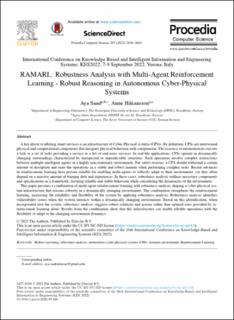| dc.contributor.author | Saad, Aya | |
| dc.contributor.author | Håkansson, Anne | |
| dc.date.accessioned | 2022-10-31T14:46:21Z | |
| dc.date.available | 2022-10-31T14:46:21Z | |
| dc.date.created | 2022-09-12T14:29:12Z | |
| dc.date.issued | 2022 | |
| dc.identifier.citation | Procedia Computer Science. 2022, 207 3662-3671. | en_US |
| dc.identifier.issn | 1877-0509 | |
| dc.identifier.uri | https://hdl.handle.net/11250/3029197 | |
| dc.description.abstract | A key driver to offering smart services is an infrastructure of Cyber-Physical systems (CPS)s. By definition, CPSs are intertwined physical and computational components that integrate physical behaviour with computation. The reason is to autonomously execute a task or a set of tasks providing a service or a list of end-users services. In real-life applications, CPSs operate in dynamically changing surroundings characterized by unexpected or unpredictable situations. Such operations involve complex interactions between multiple intelligent agents in a highly non-stationary environment. For safety reasons, a CPS should withstand a certain amount of disruption and exert the operations in a stable and robust manner when performing complex tasks. Recent advances in reinforcement learning have proven suitable for enabling multi-agents to robustly adapt to their environment, yet they often depend on a massive amount of training data and experiences. In these cases, robustness analysis outlines necessary components and specifications in a framework, ensuring reliable and stable behaviour while considering the dynamicity of the environment. This paper presents a combination of multi-agent reinforcement learning with robustness analysis shaping a cyber-physical system infrastructure that reasons robustly in a dynamically changing environment. The combination strengthens the reinforcement learning, increasing the reliability and flexibility of the system by applying robustness analysis. Robustness analysis identifies vulnerability issues when the system interacts within a dynamically changing environment. Based on this identification, when incorporated into the system, robustness analysis suggests robust solutions and actions rather than optimal ones provided by reinforcement learning alone. Results from the combination show that this infrastructure can enable reliable operations with the flexibility to adapt to the changing environment dynamics. | en_US |
| dc.language.iso | eng | en_US |
| dc.publisher | Elsevier | en_US |
| dc.rights | Attribution-NonCommercial-NoDerivatives 4.0 Internasjonal | * |
| dc.rights.uri | http://creativecommons.org/licenses/by-nc-nd/4.0/deed.no | * |
| dc.subject | Reinforcement Learning | en_US |
| dc.subject | dynamic environment | en_US |
| dc.subject | autonomous cyber-physical systems (CPS) | en_US |
| dc.subject | robustness analysis | en_US |
| dc.subject | Robust reasoning | en_US |
| dc.title | RAMARL: Robustness Analysis with Multi-Agent Reinforcement Learning - Robust Reasoning in Autonomous Cyber-Physical Systems | en_US |
| dc.title.alternative | RAMARL: Robustness Analysis with Multi-Agent Reinforcement Learning - Robust Reasoning in Autonomous Cyber-Physical Systems | en_US |
| dc.type | Peer reviewed | en_US |
| dc.type | Journal article | en_US |
| dc.description.version | publishedVersion | en_US |
| dc.rights.holder | © 2022 The Authors. Published by Elsevier B.V. | en_US |
| dc.source.pagenumber | 3662-3671 | en_US |
| dc.source.volume | 207 | en_US |
| dc.source.journal | Procedia Computer Science | en_US |
| dc.identifier.doi | 10.1016/j.procs.2022.09.426 | |
| dc.identifier.cristin | 2050880 | |
| cristin.ispublished | true | |
| cristin.fulltext | original | |
| cristin.qualitycode | 1 | |

